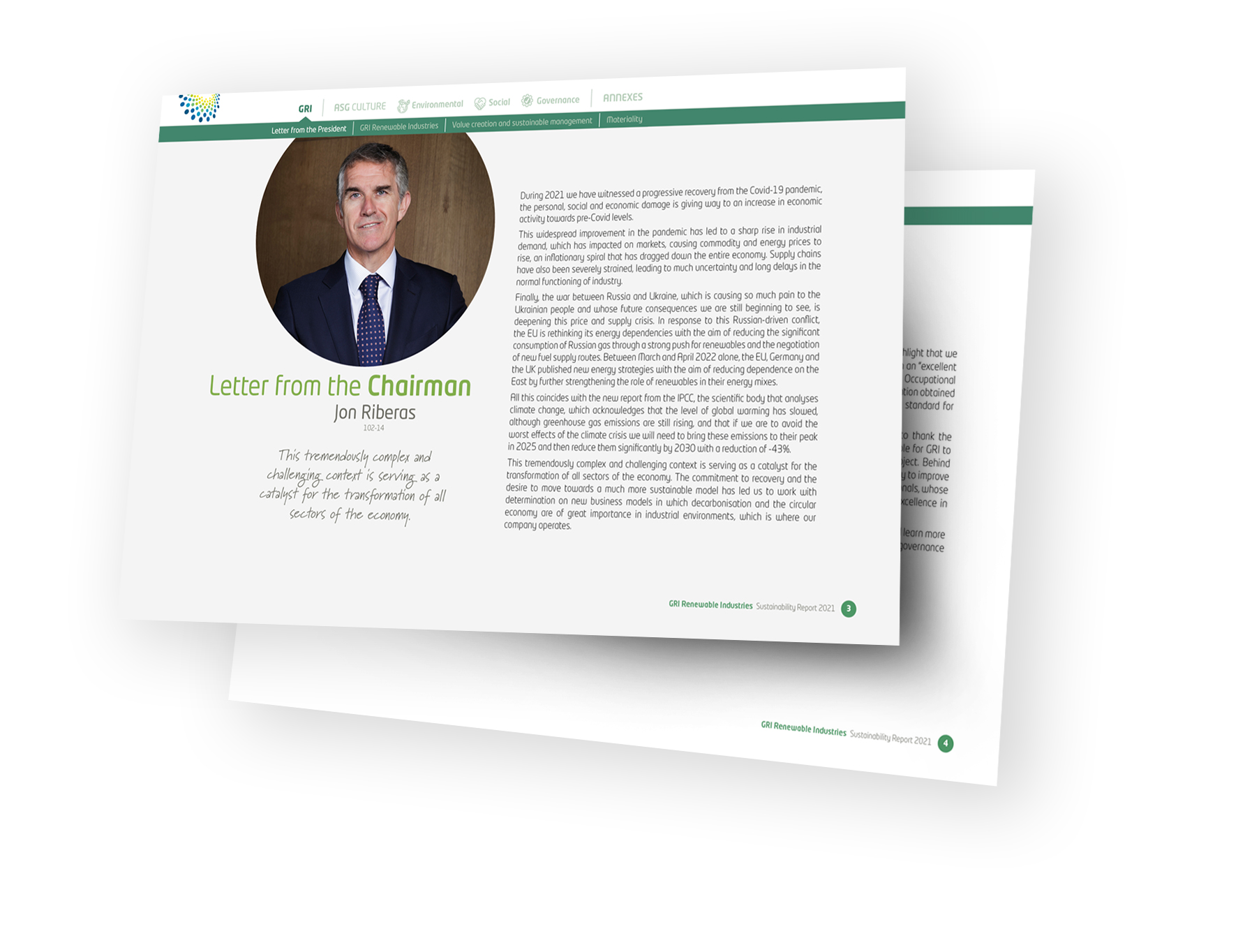
I am pleased to present our Sustainability Report 2021, in which we have sought to reflect and summarize the main data and events of this financial year.

In 2021 we have witnessed gradual recovery from the Covid-19 pandemic, with personal, social and economic damage giving way to an increase in economic activity towards pre-COVID levels. This widespread improvement in the pandemic has led to a sharp rise in industrial demand, which has impacted markets, causing commodity and energy prices to rise, an inflationary spiral that has dragged down the entire economy. Supply chains have also been severely strained, leading to much uncertainty and long delays in the normal functioning of industry.
Finally, the war between Russia and Ukraine, which is causing so much pain to the Ukrainian people and whose future consequences we are still beginning to see, is deepening this price and supply crisis. In response to this Russian-driven conflict, the EU is rethinking its energy dependencies with the aim of reducing the significant consumption of Russian gas through a strong push for renewables and the negotiation of new fuel supply alternatives. Between March and April 2022 alone, the EU, Germany and the UK published new energy strategies with the aim of reducing dependence on the East by further strengthening the role of renewables in their energy mixes.
This accords with the new report from the IPCC, the United Nations scientific body that analyses climate change, which acknowledges that the level of global warming has slowed, although greenhouse gas emissions are still rising, and if we are to avoid the worst effects of the climate crisis, we will need to bring these emissions to their peak in 2025 and then reduce them significantly by 2030 with a reduction of -43%.
This tremendously complex and challenging framework is driving the transformation of all sectors of the economy. The commitment to recovery from the COVID pandemic and the desire to move towards a much more sustainable model has led us to work with determination on new business models while decarbonization and the circular economy are of great importance.
In the renewable energy sector, the situation is both difficult and hopeful. The new geopolitical context, together with the situation in the energy markets, requires a dramatic boost to renewables to become more independent from a highly volatile fossil fuel supply as soon as possible.
The wind sector has a huge opportunity to develop new capacity, although it will have to overcome the rising costs mentioned above and the strong competition in the auctions, which are pushing many of them into a loss-making situation, which will not be sustainable for much longer.
At this juncture we present the GRI Renewable Industries Sustainability Report for the 2021 financial year. For yet another year, we renew and maintain our commitment to the Global Compact, promoting compliance with the 10 Universal Principles and aligned with the Sustainable Development Goals.
GRI Renewable Industries’ 2021 financial year was characterised by reasonable growth overall, with 20% more towers and flanges produced than in 2020, along with an investment of EUR 90 million. In terms of greenhouse gas emissions, direct emissions have increased by 3%, a positive value considering the increase in production mentioned above. In any case, the measures that are being implemented this year will hopefully be reflected in the 2022 inventory, where we want to see CO2 emissions start to decouple from industrial production.
This year we proudly received a B rating from CDP, the prestigious climate change rating agency, which awarded us a silver medal thanks to our reporting and performance in terms of emissions. This is undoubtedly very good news that encourages us to keep pushing towards our decarbonization plan.
GRI Renewable Industries is a company with a clear focus on people, where our commitment to the health and safety of our employees goes far beyond the obligatory, being a strategic pilar that is always present in decision-making and in the design of work plans. Regarding safety, I would like to highlight that we have 6 factories, one more than last year, with an “excellent performance” classification according to the Occupational Risk Prevention Index (IPRL) or the new certification obtained by GRI Forjas de Iraeta under the ISO 45001 standard for Health and Safety management.
Finally, I would like to take this opportunity to thank the work and effort of all those who make it possible for GRI to continue advancing steadily in its business project. Behind these milestones is the collective work, the ability to improve and the commitment of a great team of professionals, whose dedication allows us to maintain the level of excellence in service to which our customers are accustomed. I invite you to take a closer look at this report and learn more about our progress on environmental, social and governance issues.
Thank you very much.

Por favor, gira tu móvil para navegar